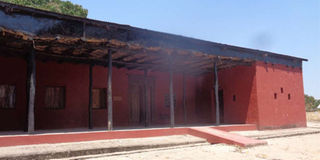Between Arusha and Kigoma

Livingstone's house in Kazeh 15km from Tabora. PHOTO| RUPI MANGAT
What you need to know:
- The next morning, we ask for direction to Livingstone’s house and drive along roads lined with humongous mango trees that grew along the slave routes.
- Parts of Tabora are single-storeyed mabati quarters with swaying palms reminiscent of old Arab neighbourhoods.
- The Tabora of the 1920s to 1960s has a rich Indian presence, with double-storeyed family homes complete with year and name on the facades, and the Sikh Temple dated 1927.
- They became property of the state during Nyerere’s socialist regime.
Tabora, which is a town that has always intrigued me, is 650 kilometres west of Arusha.
David Livingstone and Henry Morton Stanley, the hard-wired calculating British-born American journalist spent five months at Kazeh near Tabora in 1872.
We arrive at midnight and despite the hour, we’re warmly welcomed at Orion Tabora Hotel.
Built somewhere between 1900 and 1914 by the German colonialists, the hotel was called the ‘Kaiserhof’. It was to be the guest house for the kaiser (king) and barons when they came to visit Tabora. Unfortunately, with the outbreak of WWI, the king never came to Tanganyika.
Meanwhile, the Belgium army in next door Congo marched into Tabora and the earliest image of the hotel so far, was taken in 1916 when the army entered town.
The next morning, we ask for direction to Livingstone’s house and drive along roads lined with humongous mango trees that grew along the slave routes. Parts of Tabora are single-storeyed mabati quarters with swaying palms reminiscent of old Arab neighbourhoods.
The Tabora of the 1920s to 1960s has a rich Indian presence, with double-storeyed family homes complete with year and name on the facades, and the Sikh Temple dated 1927. They became property of the state during Nyerere’s socialist regime.
There’s no signage leading to Livingstone’s house – and few know of it. 15 kilometres out of town, a woman points to the direction. “Livingstone came to do some work like spread the name of God,” Amina tells us in Kiswahili. Beyond that, she knows nothing else.
The village she points towards is Kazeh. The sandy path that leads to it, on a small hill along rural homesteads and ubiquitous mango trees, doesn’t see many vehicles.
Two women play bao by their hut. It’s dry everywhere except for the mango trees. Twenty minutes later, following an old man on a bicycle who introduces himself as a guide, we stop by a clutch of towering mango trees that were there in 1857 when Burton and Speke reached Ujiji on the shores of Lake Victoria, becoming the first to document it. Later, Livingstone and Stanley spent months here in 1871/72.
It was here, in June 1871, that Stanley rested and regrouped his porters before marching on to Ujiji.
Stanley had been sent out by the fiery editor of The New York Herald to bring back news of the most famous explorer at the time – Livingstone – who no one had heard from in five years.
At the now renovated abode of Livingstone, you can view Livingstone’s letters and Stanley’s published articles in the New York Herald; a lock of Livingstone’s hair; a piece of the mango tree where he died and the yokes that held slaves captive and more.
There is a map of Tanzania;s slave route on display, too; Tabora was the half way town between Zanzibar (643km east of Tabora) and Ujiji (563km west of Tabora). At the time, the richest Arabs in Tabora lived in mansions surrounded by gardens.
After finding Livingstone in Ujiji, both men explored Lake Tanganyika a little and marched back to Tabora. Stanley returned in 1876 to chart it and confirm if it was the source of the Nile.
Stanley urged Livingstone to return to London – he was weak – but Livingstone refused, intent on proving the Nile’s source and ending slave trade. On March 14, 1872, both men parted. On August 25, 1872, Livingstone left the house to travel deeper into Congo never to return. And Stanley, with his scoop of the century, became a celebrated journalist.
www.rupitheafricantrotter.wordpress.co
FACT FILE
Tarmac from Arusha, past Tarangire and through the Great Rift Valley. Stop at Babati and Singida – the city of rocks and little fresh and salt water lakes. Tabora is 330 kilometres away.
Ujiji and Kigoma on Lake Tanganyika are 410km west. Carry your passport, Yellow Fever card and make sure your car meets Tanzanian requirements. There are good, inexpensive hotels (up to Sh5,000 for a room) en route.




